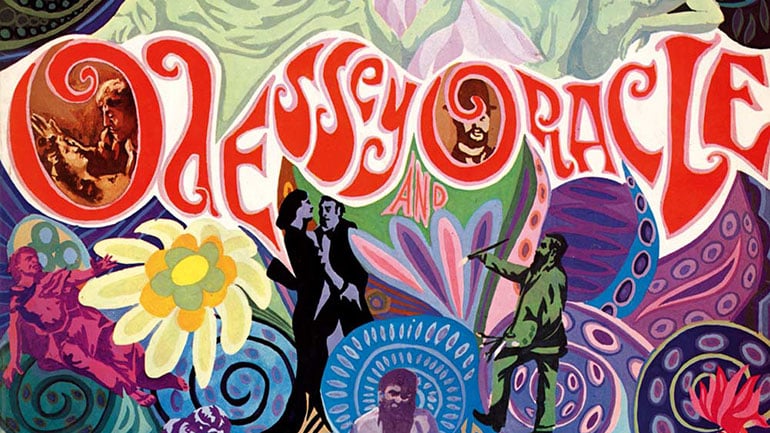Odessey and Oracle: A 50th Anniversary Reflection on the Zombies’ Paramount Album

The Zombies second album, Odessey and Oracle reached the top three albums on WRSU this past month, confirming its transcendence to younger generations. My introduction to The Zombies was their hit, “Time of the Season.” I only began hearing the Zombies through this 50th anniversary edition of Odessey and Oracle, that was added to WRSU’s rotation. I may not be a Zombies specialist, so if you’re looking for expertise, there are 50 years’ worth of reviews of this album. Consider this take on the album, a new fan’s perspective.
1968 marked the year of the first interracial kiss on American television, Americans traveling to the far side of the moon, the assassination of Martin Luther King Jr, and many other unforgettable events. It also carried weight in music history, with the release of (my favorite musical) Hair, Simon and Garfunkel’s bookends, the opening of the Fillmore East venue in NYC, and, in England, the release of Odessey and Oracle by The Zombies. Unfortunately, even before the album was released, The Zombies broke up.
The album takes off with my personal favorite off the album, that is “Care of Cell 44”. It’s the kind of optimistic, melodic song that could make the morning commute a little easier, or a frown less severe. When a song can affect one’s mood like that, it has, in my eyes, done its job. Whatever silly, perhaps cheeky lyrics or connotations that the lyrics might allude to, has been stripped to the joyous jingle that it is. The song’s “sunshine everyday” complexion, is infectious.
The album is better seen through the lens of a time machine, back 50 years ago. In the realm of Odessey and Oracle, nostalgia takes on a new level. The way the world began to lose its innocence in the mid to late 60’s is represented in the music and lyrics on this record. I can imagine the teenagers who bought this album in the late 60’s, reminiscing of simpler days. Girls may be thoughtful of their old long poodle skirts and high hair, while they sat on their new retro chairs, in a checker printed mod dress with white gogo boots, and long, silky hair. “Beechwood Park” is the perfect specimen for the reflection of a summer gone by, before the worries/realities of fame and work.
I’m there in 1968, but then I open my eyes to 2018, and all this music sounds like is the very genre of music that Pitchfork compares it to, “much like The Kinks’ Village Green Preservation Society— were idealized harbingers of today’s indie pop.” The innocent appeal of the Zombies would fit the upbeat, pop scene that indie bands have continued to break into today. Take the local band, The Happy Fits, for example. There is no doubt that the band’s “Dirty Imbecile” tune, could have opened for Odessey’s “Time of the Season” at a New Brunswick basement show sometime last semester.
The way the album cover of Odessey and Oracle looks alludes to the stereotypical trippy hippy music we might attribute it with today. Likewise, the appearance of the band members themselves resembles The Beatles. It must have been intimidating to follow such a crowd sweeping band like The Beatles. I don’t think that anyone, not even The Zombies themselves, had prepared for the impact that they would have on the evolution of pop music.
“A Rose for Emily” has to be the most melancholy track on the album, touching on the fear of dying alone. This adventurous leap in moods on the album, is what kept many people from liking the Zombies. Emily flows gracefully into “Maybe After He’s Gone”. The record begins crawling back upwards, back to the upbeat pop experimentation. Colin Blunstone’s outstanding voice is shaded in with uncertainty and at times sounds like he’s saying, “Is it alright if I…?”, and they take a leap of faith with the music.
As the album nears its end, it’s met by an old friend of many Americans, “Time of the Season”. This hit song fluctuates on my rating scale solely because it is so popular. It is like the star of the football team in high school, unavoidable yet somewhat attractive. Nevertheless, you never really took the time to get to know it. I decided to listen to it through a few extra times, actively, to let me warm up to it. My first thought was that there’s no doubt that the “Who’s your daddy?” line would make headlines if written by a band today. As I got to know the song, however, it seemed as if each verse and chorus became more complex than the one before it.
On the outside, the song is like a dashing young man, a jock in a letterman jacket, driving around in a convertible. However, as soon as the keyboard joins in the song, there is a splash of color and an unkemptness to it. The vocals, begin to be echoed by celestial women, and get more unsettling, as they develop. The song breaks free during the instrumental break and it’s nothing like I’ve ever heard this song sound like before. Maybe I hadn’t listened as closely in the past, or maybe I simply hadn’t listened all the way through. “Time of the Season” is a prim and proper pop song that grows into a rock song, reflecting social and music changes in the late 60’s. This embodiment of the 1960’s is what shapes the song into an icon of its time.
This album seems to have had a substantial impact on a variety of pop music today. I’ll continue to wonder if the band ever had the chance to celebrate the album together, as their fans did. However, they did reunite in recent years to play the album with remaining members.
If you’re still unfamiliar with The Zombies, and you’re into today’s alternative/indie pop music, grab your headphones, sit on a park bench, and experience Odessey and Oracle for yourself. There is thrill in conceptualizing another time and place in music, as if you’re hearing these songs on the radio or a record player, for the first time.
by Bri Born
The opinions expressed above are solely those of the author, and do not necessarily reflect those of WRSU-FM, its staff, management, or Rutgers University.
